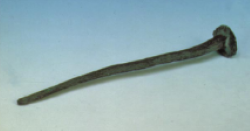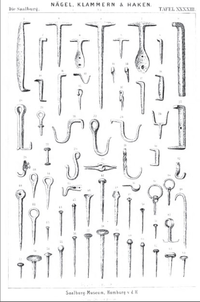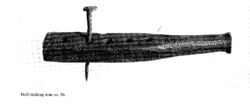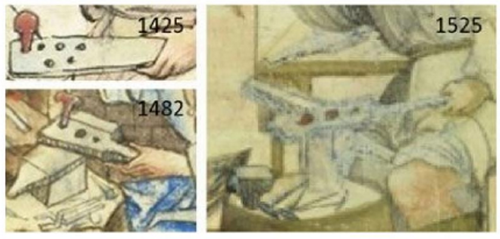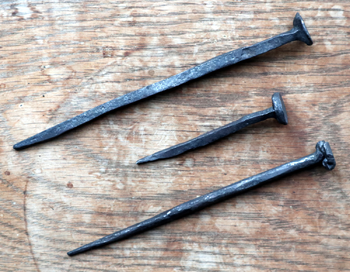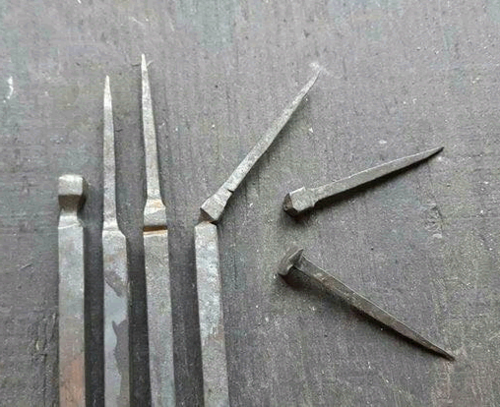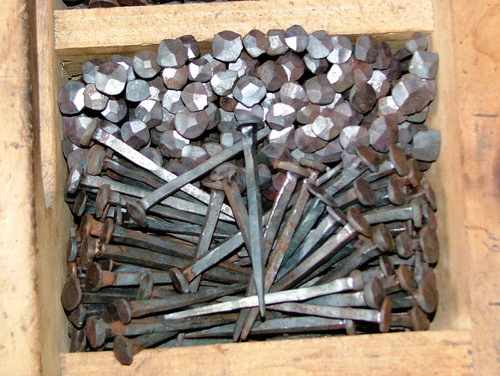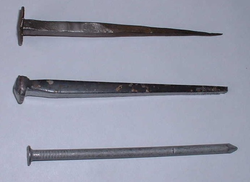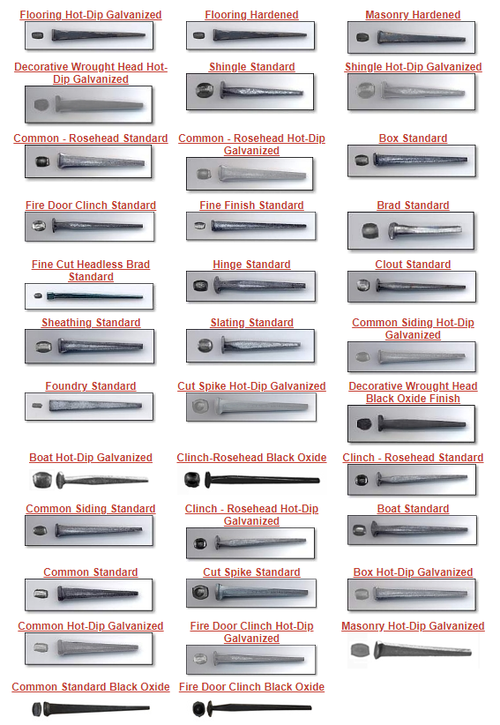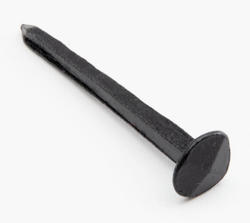A Short History of Nails
Introduction
I've noticed a trend in all the woodworking circles I travel in (the SCA, SAPFM, various online furniture geek groups): a strong bias against the use of metal fasteners of any sort (nails, screws, rivets, etc.). I think some feel like it's a cheat. Like you couldn't think of some cleverly housed dovetail or another complex joint to use there rather than a vulgar nail? Or that's just it, it's suggestive of a lower class of furniture. Especially in SAPFM, there's a strong bias to only the highest style pieces. Stunning work often exceeding the originals in quality. But nary a nail to be found.
This is, of course, wrong-headed. There are many areas in furniture making that require a fastener, someplace you can't count on glue (especially hide glue) to survive over the long haul. Even those amazing 18th Century pieces have a few nails here and there to hold those bold pieces of trim, they are just hiding it well.
And there are many vernacular forms that are worthy of study and recreation where nails were what was used in the construction. Finally, there was a time before everything cool had dovetails. I just completed a project, a 15th Century Ambry, that was assembled with nails (as the original was).
Furniture from that period isn't studied or reproduced much because it's not very flashy or complex. This ambry and pieces like it were made by carpenters, not joiners and the trade of the cabinetmaker had yet to emerge. Carpenters built houses primarily and also simple furniture of a type that's called "boarded". This uses wide boards that are nailed or pegged together. This is a limited repertoire that gives you mostly variations on a box. Useful things, sturdy things, but heavy both physically and aesthetically. It's the strength of those fancy joints used by the joiner and the cabinetmaker that gave furniture the strength to shed their bulk.
Speaking of England specifically, there are basically two woodworking trades at the end of the 15th Century: carpenters (nascent joiners) and turners. As we get into the 16th Century and the level of wealth raises to the point where the demand for nicer furniture grows, we see first the joiner split off and then the cabinetmaker trade emerge. By charter (again, in England)* carpenters could only nail things together. Mortise and tenon joints were reserved for the joiner. And only cabinetmakers could use the more complex joints. Ans all of these guys were trying to keep the turners down.
There's a lot of fascinating history there, so at odds with the modern period furniture making crowd I am part of where we're a one-man shop that has to process stock, build the thing with whatever joinery is required, do turning and carving if required, then finishing, upholstering, etc. Few period craftsmen (of any period) were called upon to have such a wide range of skills.
But let's take it back to boarded furniture and nails. By the late fifteenth century, boarded or nailed furniture is associated with second rate or lower class furniture. Even so, it remained popular (there are a lot more peasants than nobles) such that many of these forms persisted until the industrial age put fashionable looking furniture into the reach of the working class.
What drew me to the ambry project was the 6 pierced gothic designed on the front of the cabinet. Ambries were used to store food and dry goods, so some sort of ventilation was required. They used these designs, backed by some sort of cloth to permit airflow and keep the food safe. Aside from the carving, an ambry is a bookshelf with a door, not a super complex or a challenging bit of woodworking.
Oh, and it was nailed together. I haven't used nails much in my previous projects. Not because I eschew vernacular or early period furniture, but because I suck at driving nails. I avoid them like the plague in my home renovation projects. Any line you can draw, I can saw, with a variety of saws. But I can bend the crap out of a nail like no one else. So I approached this project with some excitement to see if I could pull off the carving and fear that I would ruin it with a hammer trying to drive all these nails.
Since most people looking at the project would be unfamiliar with nails and their finer points (as it were), I felt that I needed to dive into nails a bit in the documentation. To give a little context, if nothing else. I came away with a lot more interesting information than I needed for the documentation. Not wanting such cool information to go to waste, I bring it all out into the light here in this article for the edification of all.
My goal is to illuminate the long history of nails, their importance to society, and their changes (or lack thereof) through history. As grand as that sounds, nothing much interesting happened to nails during the period focused on by the SCA as we'll soon see. Many of the references I found on nails prior to the Renaissance all point back to Henry C Mercer's Ancient Carpenter's Tools. As excellent a book as it is, with many photographs and good references, it's very nearly 100 years old now. A complete bibliography appears at the end on the off chance this length article doesn't satisfy your need to know about pointy metal things.
The History of Nails
Prehistory
Nails, especially iron nails, don't hold up well over the long haul so very old nails are very rare. More often we find nail making tools from which we can infer the size and composition of nails they made. The earliest nails found so far are bronze and date from about 3400 BCE. There are many references to nails in the Old Testament of the Bible implying they were widely known in the centuries before the Common Era.
Mediterranean
A wreck discovered off the Israeli coast, dated to approximately 400 BCE was found to be partly constructed with clenched copper nails. These were 7" to 12" long and based on the trace mineral content, the copper was from Cyprus.[1]
Romans
Beginning around the year 83 CE, the Romans began building the fortress Inchtuthil in what's now Perthshire in northern Scotland. This would turn out to be the most northerly military fort the Roman Empire ever constructed. After just 4 years, with parts of the fortress still under construction, the legion stationed there was moved further south and the fortress was partially dismantled and abandoned.
While excavating the site in the summer of 1960, archeologists discovered a horde of nearly 1 million iron nails ranging in size from 2 ½ inches to 15 inches long. This 10 ton batch of nails was no doubt made on-site during the construction of the fortress but deemed not worth transporting south. Therefore, they buried them to keep the Scots from recovering the high-quality iron and making weapons. You have to keep a close eye on those unruly Scots.[2]
Other examples of Roman use: Blacksmithing implements, including nail making tools and an iron woodworking plane, were found at Calleva near Reading, Hampshire, England dating from the 2nd-3rd century CE.
A 1st century CE nail-making anvil was among the tools found at a Roman camp near Kaiserlautern, Germany
A nail anvil was found, along with a perforated bar at the Saalburg Fortress, near Homburg vor der Hohe, Hesse, Germany. Occupied from 120 CE to about 250 CE. At the left is a number of items found at the fortress including, at the bottom, nails.[3]
Vikings
Yes, the Vikings used nails, a lot of nails. Those longships had lapstraked (longitudinal overlapping planks) hulls. A technique is also known as clinker-built and the planks were fastened together with copper or iron nails that were clenched or sometimes rivets. So it comes as no surprise to find several nail making tools in the Mästermyr Tools Chest from Gotland. And these tools are essentially identical to the Roman finds from a millennium earlier.[4]
At the right is an obore from the Mastermyr find. It's a tool used to form heads on nails.
Late Medieval Germany
The house books of the Mendelschen and Landauer Twelve Brothers contain over 1,300 illustrations describing all manner of crafts and manufacturing from the 15th to the 19th century. It contains 5 pictures of nail-smiths. Below is a compilation of three all showing the process of heading a nail. Compare this to the nail heading tool above from the Mastermyr find. The nail-smiths in the Mendel Housebook: Ott Nagler (c. 1425), Frycz Zorn (1482), Kuntz Peck (1525).
Tudor England
A number of nails from the Mary Rose, built in 1509 and sunk in 1545 survived, even submerged in seawater because they were encased in tar. These nails look identical to the Roman examples.[5]
Innovation Begins
From prehistory to 1580 nails have been made using the same two-step process:
- Create a sheet of iron, then cut the sheet into strips or rods
- Heat the rod stock, fashion a nail shank, clip off a piece, and create the head.
The image below from Colonial Williamsburg illustrates the steps:
In 1580, some folks in what is now Belgium invented a water-powered "slitting mill" and by 1590 a copy was operating in Dartford, England. This mill used a large cleaver to shear iron sheets into thin rods which were then sold to nail-smiths. This specialization allowed the smelting of iron and the creation of iron sheets to be separated from the task of actually making nails, greatly increasing production by increasing the number of smiths that could participate.
The resulting nails were identical to the previous ones in all respects and production continued to be rather slow.
Adam Smith, in The Wealth of Nations (1776), points out that by far the most efficient nail making came from shops devoted exclusively to the craft. He estimated that a common smith could produce 200- 300 nails per day--and very poor ones at that. A smith accustomed to making nails as a sideline fared better--his daily production would average between 800-1,000 nails. However, boys under twenty, trained exclusively in the trade, could by exertion produce up to 2,300 nails per day.
That sounds like a lot of nails, right? According to Colonial Williamsburg's Master Blacksmith Kenneth Schwarz recreating just one average-sized building consumed 30,000 nails of all types to fashion the framing, siding, roofing, and flooring. [5]
Things didn't change until the late eighteenth century.
Cut Nails
In 1775, Jeremiah Wilkinson, a Rhode Island inventor devised the first machine to cut individual nail blanks from iron sheets. The result still needed to be "headed" by another machine or by a nail-smith in the usual fashion.
Nails created with this process have a distinct shape with a blunt, usually rectangular cross-section rather than the pointed square cross-section of wrought nails and were called "cut nails" where hand-forged nails continued to be called "wrought nails".
By 1795 there were machines that could cut and head nails in one operation. These water-powered machines could churn out nails at a prodigious rate and cut nails quickly became the dominant form of nail. Wrought nails were still made and for a variety of reasons, some applications were too specialized for efficient mass production by the machinery of the day or places where clenching was needed, as this earlier type of cut nail wasn't pliable enough clench without breaking.
Machines continued to improve through the 1800s making more types of nails and at a faster rate.
Wire Nails
Wire nails, the type we are familiar with today, was developed in Europe in the middle of the nineteenth century. By the 1850s several wire nail factories were in operation in New York using machines either imported from Europe or copies of their designs. These machines produce smaller nails (2d and smaller).
Then American innovation took over and through the 1860s and 1870s the machines were improved and began making the full range of nails.
The development of the Bessemer process during the 1880s allowed for the production of inexpensive soft steel. The availability of cheap steel accelerated the adoption of the wire nail. Steel is drawn through plates to make wire of various sizes and a machine cuts it to length, creating the point in the process and heads it in one operation. These machines produced nails, faster and much more cheaply than the cut nail machines. And, the machines themselves were much simpler and less expensive.
An 1888 article states:
" Nails of a very different kind, manufactured from steel wire, have been in use for a number of years in America and for a longer period in Europe, and in both places, they have been very favorably received and are fast superseding the common cut-nails for many purposes."[6]
The popularity of using iron for nail making quickly waned. In 1886, 10 percent of the nails produced in the United States were made of soft steel wire. Within six years, more steel-wire nails were being produced than iron-cut nails. By 1913, 90 percent of the nails produced were wire nails.
Available Nails Today
We live in a time of plenty, the entire gamut of nails are available to us. Sometimes not very inexpensively, but you can get them. There's someone selling the Roman nails from Inchtuthil Fortress, one at a time. It will take him a while to sell all 864,000 that are still recognizably nails.
Wrought Nails
Wrought nails, made in the traditional way, are available today. Several blacksmiths maintain websites and sell their wares. Nails aren't their primary stock, much as was the case in period, so they are often out-of-stock. You'd do better visiting a blacksmith or attending some artisan fair or reenactment event (Revolutionary War or French & Indian War) where there's an active blacksmith. You can expect to buy them in small quantities and pay between $1 and $3 each.
You can also find both new and vintage wrought nails on eBay and Etsy. More care needs to be exercised here. I have seen a number of sellers reselling 5 or 10 nails from Tremont for $9 and calling them "replica" and not mentioning Tremont. It's a good deal for them, $9 for $1 of nails. You won't get rich that way, but they are making sales. I have also seen rusty modern cut nails sold as vintage nails. Nails for pinning boards to concrete or block walls look much like old cut nails, but they are hardened steel. If you aren't paying $2+ apiece, they are probably bogus. Example of a good listing:
Cut Nails
Cut nails are still made today for applications such as hardwood flooring, horseshoeing, restorations, and period furniture making. The Tremont Nail Company operates a couple of 100+-year-old nail making machines to produce 15 different types of cut nails, most in both galvanized and black oxide finish. Nails in furniture making sizes (8d)run about $20/lb (a pound of 2" nails is about 48 nails). At Home Depot, $20 will get you more 2-1/2" nails than you can comfortably carry to the checkout and they aren't nearly as cool.
Die Forged Nails
While America was innovating new machines and types of nails, France was perfecting a new way to make the same old nail. A factory in Creill, France created machines that use dies to stamp out mild steel nails that look like wrought nails, mostly. Inexplicably, this operation Clouterie Rivierre has been a going concern since 1888 and is still making nails. They are available in 23mm (1" or 2d), 35mm (1.3" ~4d), 40mm (1.6" ~5d), 50mm (2" or 6d), 70mm (2.75" or 9d) in blued steel or black oxide finish.
Like most things from France, it's very difficult to buy them directly, but you can obtain them through Lee Valley. They run about the same price as cut nails from Tremont and look a little more period-appropriate for use in place of wrought nails. I have obtained a sampler of 140 nails, but haven't used them yet. There were too few for the Ambry project and I had sufficient cut nails on hand and a tight timeline. Perhaps the next project.
Shapes and Sizes
Nails throughout history came in a great variety of sizes and while they all had the same shank profile, there were many types of heads. An article from the trade magazine "The Ironmonger" dated April 5, 1924, relates the story of Ambrose Crowley, a Quaker living in London who by 1682 had set himself up as a "naylor". Along with many details of the trade, the article lists the types of nails available to tradesmen of the William & Mary era:
|
|
One can only speculate on what "Spikes for ye King" were used for, but they sound…large.
Common nails in the late eighteenth century look like this (courtesy of Eric Sloan's Museum of Early American Tools):
The tradition of describing nails in "pennies" comes to us from medieval England where it originally described the cost of 100 nails of a given size. For example, the account records of the Church of St. Mary-at-Hill (London) from the year 1477 show -
'ffor a c of v peny nayle vd'
It's a church, they're using Roman numerals here, so "for 100 5d nails 5d"
While prices in the pre-industrial world changed slowly, they did change. So, at some point around this time, they decided to standardize on the length of the nail and let the price float rather than having mass confusion. In 1471 for example, "fippenynayl" were only 4d per 100. In 1477 "xpenynayll" were only 8d per 100; in 1494 "sixpenynayle" were 5d per 100.[7]
According to this standard, nails start at 2d, which is 1" in length, and range up to 100d (the largest size for which I've seen a reference) which is 8” in length. From 2d to 16d each additional penny increases the length by 1/4". Above 16d, the size increases by half inches. Nails longer than 100d or shorter than 2d are described by their actual length in inches. Note that above 10d, we start skipping numbers as shown in the table below:
| Size | Length | Size | Length | Size | Length |
|---|---|---|---|---|---|
| 2d | 1" | 8d | 2½" | 30d | 4½" |
| 3d | 1¼" | 9d | 2¾" | 40d | 5" |
| 4d | 1½" | 10d | 3" | 50d | 5½" |
| 5d | 1¾" | 12d | 3¼" | 60d | 6" |
| 6d | 2" | 16d | 3½" | 80d | 7" |
| 7d | 2¼" | 20d | 4" | 100d | 8" |
We still use this nomenclature today (in America), elsewhere they've moved on to the much more boring length in mm. For furniture making 4d, 6d, and 8d are the most useful sizes and are the ones I keep "in stock".
Interesting Legal Aspects
From the founding of their founding to the Revolutionary War, the American colonies heavily depended on nails imported from England. While small scale production began almost immediately at places like Jamestown, English trade laws discouraged any large operations. Therefore, nail-making became something of a cottage industry where anyone with the skills to make nails made some in their spare time. Such production hardly put a dent in the demand and the value of nails soared as a market developed for them.
Colonial officials were at least cognizant of the problem, and the l640's record two attempts to deal with it. The sixth act passed by the General Assembly which sat in March 1642 attempted to prevent the excessive and exorbitant engrossing of certain commodities brought into the colony. Nails were among the enumerated items which were forbidden to be sold at a higher rate than that at which they were imported.[8]
Their importance was such that they were used as a medium of exchange. In the early l640's a Virginia court order was issued for Roger John, a Northampton County blacksmith, to pay £7 10s and 1900 nails to William Sterens, a boatwright.[9]
Occasionally nails even crept into transactions as late as the early eighteenth century. For example, in 1709, John Custis III purchased five hundred acres of land on Chincoteague Island in Accomack County: "for a like amount of land in another part of the county and ten thousand 16d nails.[9]
Lacking as many new nails as they needed, it seems some Virginians found creative ways to obtain more. An act passed in the House of Burgess (the Virginia General Assembly) of February 1643 states:
"And it is further enacted by the authority aforesaid, That it shall not be lawful for any person so deserting his plantation as afore said to burne any necessary houseing that are scituated thereupon, but shall receive so many nailes as may be computed by 2 indifferent men were expended bout the building thereof for full satisfaction, reservinge to the King all such rent as did accrew by vertue of the former grants or planting of the same from the expiration of the first seaven years."[8]
Thereafter, the burning of buildings for nails, in theory at least, required specific authorization. Such permission was granted to the person who would occupy the site on the James River opposite the unused Fort Charles in 1646. He was to be allowed to enjoy the buildings of the fort for timber or the burning of them for nails.[8]
Nor was this practice restricted to Virginia, when in 1691, a new courthouse was authorized for Kent County, Delaware, it was resolved that ". . .wee doe alsoe Concent that ye old Courthouse may be burnt to gett the nailes."[10]
The coming of the Revolutionary War made importing nails increasingly difficult and, no longer being concerned with England's trade laws, more and larger nail-making operations sprang up. Though this couldn't make up the demand and after the war, large quantities of nails were once again imported from England. However, the stage was set for the rapid expansion of the American economy and that helped spur the inventiveness that lead to innovations like cut nail machines.
As the cut nail machines were refined through the early years of the nineteenth century, their output increased to the point that by 1828 America became a net exporter of nails and a competitor on the global market. Exactly the reason England strove for so long to keep the colonies under their thumb.
Practical Notes
Now that we've explored the history of nails, what they looked like, and how they were made it's time to talk about the practical aspects of using them in projects.
There are a couple of important differences to consider when using wrought or cut nails if all you have used previously are wire nails.
- Both types require pilot holes in most cases.
- The pilot hole should be the size of the tip (for cut nails) and the size of the shaft about ⅓ of the way up for wrought nails. The pilot hole should be drilled to a depth of about ⅔ the length of the nail (unless clenching, in which case you need to drill all the way through).
- You should locate these nails carefully, both types are far harder to pull out than wire nails.
- Wire nails have a uniform cross-section along their length so once the tip pushes the wood fibers out of the way, there's nothing specific providing any grip. Non-galvanized nails have a light coat of oil to inhibit rusting before you use them, further reducing their gripping power. The shank of both cut and wrought nails vary in size along their length and have texture as well. Once the nail is driven, the wood fiber uncompresses and lock into these features. So they have far superior holding power (for good and ill).
- This is why folks burned buildings to recover the nails rather than disassembled them. Clenched nails though are forever. There's no pulling them out. You might be able to cut the shank without destroying the wood too much, but maybe not.
- The shank of cut nails (and some wrought nails) have a rectangular crosssection.
- When using them, you want to align the long side of the shank with the direction of the grain of the top board. You won't forget this more than once as that long edge across the grain makes a good splitting wedge.
- Be prepared to really whack these nails.
- The increasing size of the shank means the resistance of the wood increases as you go, more than you might think. But, that's good, this wedging action is what makes these nails far superior to wire nails.
- This part really made me nervous at first. My, mostly negative, experience with wire nails taught me that really whacking nails pretty much guaranteed I would bend them over. That didn't happen here. The cut nails are far stronger than wire nails and I only had one of the 4d nails try to bend on me.
So, what should you use in reproduction furniture?
At present, I use cut nails. Specifically, I use Tremont's "Decorative Wrought Head" nails in 4d, 6d, 8d, and 10d sizes. With a head shaped the same way as wrought nails, so once driven, they are indistinguishable from wrought nails and they hold just as well. Plus there is a ready supply and are affordable.
I intend to get some wrought nails and experiment with them one of these days, but I make too many things to use them regularly. If I am doing a commissioned piece where the customer has the desire and the budget for wrought nails, cut nails are what I'm using.
Tremont's "Decorative Wrought Head" nails come in two finished, galvanized and black oxide. Black Oxide mimics the look of nails fresh from the forge, except for the part where they would begin rusting in minutes, especially in Maryland humidity. So, that is a good choice. Most pictures of extant pieces show these dark-headed nails.
You might be surprised to learn that the galvanized nails are also a possible choice. Speaking for the Anglo-American furniture-making tradition, oak is the species of choice until the eighteenth century when mahogany supplants it, at least amongst the wealthy. However, oak is very acidic and reacts poorly with iron, quickly becoming stained black if the iron gets wet at all. You can see the effects on most pieces of surviving furniture. In fact, it's the stains from previous iron fittings that lead me to believe the door in the ambry I built originally had a full-length door.
The craftsmen knew this, of course, and used nails dipped in tin when they could get them, to avoid this effect. And later, just hid them with applied trim once that became a thing in the seventeenth century. These tinned nails look just like nails electroplated with zinc (galvanized). Chinnery mentions this, but I am still looking for solid dates for the use of tinned nails. For now, I am assuming this use was later in period than earlier, sixteenth century perhaps.
References
- ↑ Shalev, S., Kahanov, Y. & Doherty, C. Nails from a 2,400-year-old shipwreck: A study of copper in a marine archaeological environment. JOM 51, 14–17 (1999). https://doi.org/10.1007/s11837-999-0205-5
- ↑ Budrovich, N. From Ancient Scotland to Online Auctions: A Tale of Roman Nails. J. Paul Getty Museum (2020). https://brewminate.com/from-ancient-scotland-to-online-auctions-a-tale-of-roman-nails/ Retrieved 18 Dec 2020.
- ↑ Mercer, H. Ancient Carpenters' Tools (1929)
- ↑ Arwidsson, Greta and Berg, Gösta. The Mästermyr Find, A Viking Age Tools Chest from Gotland. Kungl. Vitterhets Historie Och Antikvitets Akademien, Almquist & Wiksell Intl., Stockholm, 1983.
- ↑ 5.0 5.1 LeFever, G. Forged and Cut Iron Nails. Early American Life Magazine, June 2008, pg 60-69.
- ↑ Unknown. "Builders' Hardware-III. Nails," The American Architect and Building News, Vol. XXIV, No. 660 (18 August 1888), 73.
- ↑ Nelson, L. Nail Chronology as an aid to dating old buildings. National Park Service. Technical LcaBet 48, History News, Volume 24, No. 11, November 1968.
- ↑ 8.0 8.1 8.2 Hening, W., ed., The Statutes at Large; Being a Collection of All, the laws of Virginia, Richmond, 1810, I, pg 245-327.
- ↑ 9.0 9.1 Ames, S., Studies of the Virginia Eastern Shore in the Seventeenth Century. Richmond, 1940, pg. 126-127.
- ↑ Peterson, C., "Burning Buildings for Nails,” Journal of the Society of Architectural Historians, IX, No. 3 (October 1950), pg 23.
